Catherine the Great joined the cat guard at the Winter Palace. Although the Tsarina was not too fond of purrs, she was well aware of the damage mice could do to her collection of paintings. During her trip to Kazan, the Empress commanded that 30 furry cats be delivered to her and released upon her arrival at the Hermitage. It is believed that their descendants even now protect Russia's largest museum from malevolent rodents.
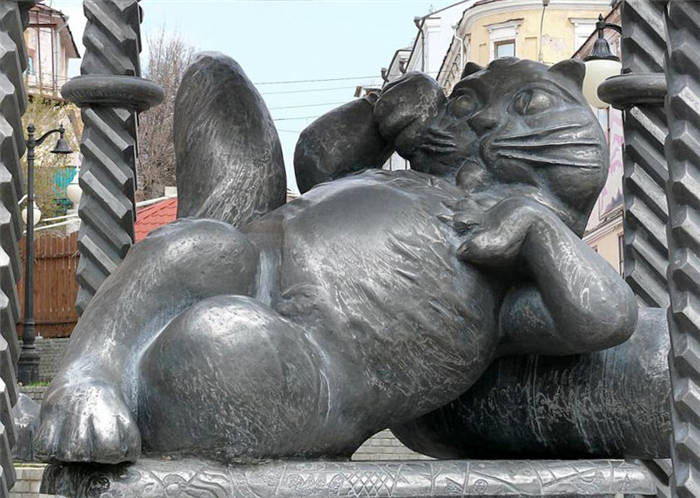
- "The cat of Kazan, the mind of Astrakhan": what do we know about Tatarstan's meowing brand?
- Who is a Kazan cat?
- Where is it
- Interesting facts
- Related articles
- A cat – museum curator
- How to get there
- The cat from Kazan. Where did this "beast" come from and why do locals and tourists love it?
- Where does Kazan Cat lie?
- Symbol of Kazan
- History of the Kazan Cat Monument
- The legend of the Kazan Cat and Elizabeth Petrovna:
- Kazan cat (Kazan). Picture:
"The cat of Kazan, the mind of Astrakhan": what do we know about Tatarstan's meowing brand?
Today, March 1, Russia traditionally celebrates Cat Day! This holiday was organized by the Moscow Cat Museum and journalists in 2004. Cats are a symbol of spring and rebirth. And for Kazan it is one of the symbols of the city. Kazan cats were known not only in our region, but throughout Russia. It is a legend not only in Kazan, but also in St. Petersburg.
We would like to congratulate our readers and their pets on this wonderful holiday! We all adore cats in our editorial office!
In honor of the holiday, we decided to give everyone a cat! No, do not hurry to buy food and litter boxes, this couple do not need any special care, but they will gladly help you to express your emotions and feelings in your telegram chats. Meet Kazan cats Alabrys and Myrau-batyr.
Alabrys is the legendary cat of Kazan. Chroniclers wrote about him, wrote legends, he was drawn on the loogues and even put a monument to him on Bauman. Myrau-batyr is the hero of the famous serial musical TV fairy tale, which was released in the last years of the Soviet Union. The basis of this fairy tale is the work of the Tatar classic Naki Isanbet "Myraubai Batyr".
So, to add our heroes to your collection, go to the link in Telegram , and in the window that opens click "Add stickers". Now you can use our cats in your chats!
And now that you've added our sticker pack, read five facts about the Kazan cat and his adventures.
Who is a Kazan cat?
According to legend, the Khanate of Kazan bred an amazing breed of fighting cats, which were famous for their fortitude and great strength. The few accounts that survived to our days say that the Kazan breed might have been bred from wild reed cats that lived in the thickets along the banks of the Volga. It is difficult to say since when Kazan could have bred this breed. Only one thing is known: today there is no classic of Kazan fighting cats.
Nowadays historians are guessing what fighter cats could really be. There is a mention that a Kazan cat could be: "with a large head, a muscular neck, a developed shoulder girdle and a short tail". According to other reports, cats may have had thick white or gray hair, as well as thick and long whiskers.
Where is it
In 2009, a monument by local craftsman Igor Bashmakov was erected at the intersection of Bauman Street with Musa Dzhalil Street. It is made of tinted aluminum and shows a kitty with a fat belly and a contented face. The fluffy beauty lies imposingly on the bed under a canopy, the roof of which is crowned with a praying mouse.
In front of the bed on a low pedestal there is a round rug with an inscription in relief: "Alabrys. The cat of Kazan. Astrakhan mind, Siberian mind. Glorious lived and slept sweetly". Those are the words you can read on the cheap popular prints.
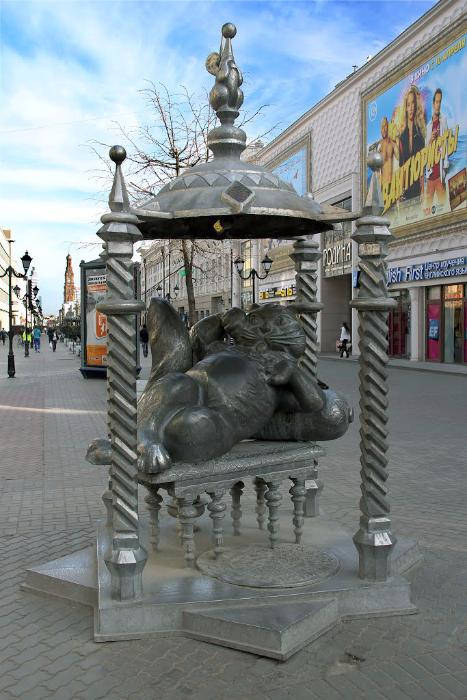
Interesting facts
- The idea of creating the monument was expressed in 2005 at the scientific conference "Kazan in the Middle Ages and Early Modern Times".
- The casting was made at the Artistic Casting Plant (Zhukovsky city).
- The monument to the cat is 3 meters high and 2.8 meters wide.
- About one million rubles donated by sponsors were spent to create the sculpture.
- A similar monument is installed in Raifa monastery on the outskirts of the city.
- Every March a festival dedicated to the symbol is held in the city. The events are held on the territory of the Kremlin and in the Hermitage-Kazan museum complex. The festival program is very diverse: you can visit exhibitions of paintings and decorative products with the image of fluffy purrs, watch movies and shows about pets, visit souvenir fairs and master classes on making animals from clay and other materials.
You can meet Alabrys and take pictures with him during a walking tour along Bauman Street. Traditionally, you have to scratch his belly: in this case, the cherished wish will surely come true. In the numerous souvenir stores located nearby, you can buy souvenirs with the image of Kazan Cat made of ceramics, textiles or metal.
Do you want to meet the Kazan Cat? Come to the capital of Tatarstan: here you can see not only this, but also many other sights of the amazing city.
Related articles
A cat – museum curator
At the royal court, the cat first appeared during the reign of Peter I. However, the tsar brought it not from Kazan, but from Europe. The animal was responsible for catching mice and rats in St. Petersburg, but he could not cope with the plague alone, of course.
This is where the story of the Kazan Cat continued. In 1745 Peter's daughter Empress Elizabeth visited Kazan and was surprised to find that, unlike St. Petersburg, this city did not suffer from an invasion of rodents. Elizaveta Petrovna asked the Kazan governor to share her secret and found out that Kazan was "guarded" by a special breed of cat. Immediately followed the highest decree to send to the capital thirty (according to other sources, three hundred – by the number of lifeguards who participated in the 1741 palace coup) the best and biggest cats of Kazan. Those, who didn't want to voluntarily give up their pets, were fined high fines.
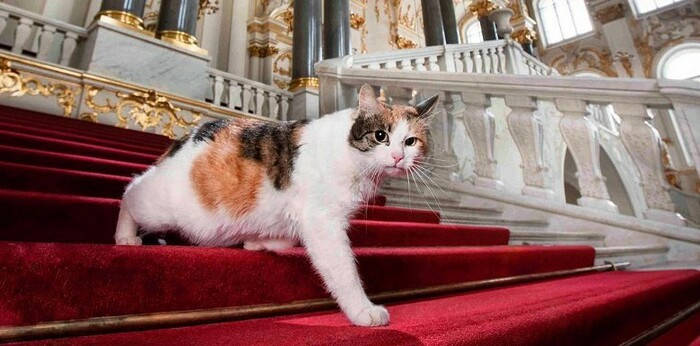
Thus the Kazan cats became residents of the capital and saved the as yet unfinished Winter Palace from an invasion of rats. Unfortunately the animals were not able to form a dynasty: according to the decree of Elizabeth Petrovna only those animals were brought to Petersburg who were not allowed to procreate. The present-day Hermitage cats, known as one of the most unusual 'sights' of the northern capital, are not directly related to them, but continue the glorious tradition of protecting the Winter Palace from rodents. And the real Kazan cats have remained in their historic homeland.
How to get there
Sculpture of the Cat of Kazan is located on a huge pedestrian area, so you will not have to look for the monument for a long time. Any local resident will gladly show and tell you the route. If you take the subway, get off at the "Kremlin" station – from there to the monument it will take about 500 meters, and it will take about 10 minutes on foot. In warm summer weather such a walk will bring lots of fun.
You can get by ground public transport. There is a bus route №70 which goes along the Kremlin street, you can get off at the bus stop "Glavpochtamt" and then go down Musa Jalil street straight to Bauman street, where you will reach the monument very easily. You can use the numerous city cabs that will take you directly to the place.
The cat from Kazan. Where did this "beast" come from and why do locals and tourists love it?
Probably no one has not heard the phrase "Orphan of Kazan," but probably not many people know about the expression "Cat of Kazan. During my first walk down Bauman Street, I went to the sculpture dedicated to this "mysterious beast.
It is a well-fed cat, half-sitting, lying on a couch with an open canopy. You can tell from his sight that he is carefree enjoying life. And on top of the canopy sits a mouse, cautiously, not wanting to become his prey. However, many tourists who have visited the cat, say that the mouse is not afraid of him and happily frolics on the roof, knowing that he can not catch it.
To take this picture, I had to take a queue and wait for about half an hour. Of all the sights on Bauman, I have not met so many people who want to make a commemorative photo, as near the cat.
This cat officially has a name (not a nickname) – Alabrys. An interesting fact is that his name comes from the ancient Turkic "ilbers". This is how the snow leopard (irbis) was called in Semirechye (parts of modern Kazakhstan, Kyrgyzstan and China).
In front of the cat's bed in a circle is written: "Alabrys. The cat of Kazan, the mind of Astrakhan, the mind of Siberia…". This symbolizes the khanates conquered by Ivan the Terrible.
Since during my visit to Alabrys, the inscription was covered with a thick layer of compacted snow, I had to use a picture from the Net for the full view of the inscription.
This is not the only cat monument in town. Another sculpture, dedicated to the domestic cat, is located in one of the courtyards of the Staro-Tatarskaya Sloboda. And the third cat, "teaches" literature at the university.
So why do Kazan cats deserve such love from residents and tourists? According to the official version, Empress Elizaveta Petrovna, was well heared of Kazan cats – rat-catchers. In the XVIII century in Kazan there was a special breed of cats, not tall on their feet, with a muscular neck and a short tail. Unlike their relatives of other breeds, thanks to their body structure they were able to get into places where others had problems. Thus they killed more rodents. For the better struggle against mice and rats in the Winter Palace, the Empress issued a decree "On sending cats to Her Imperial Majesty's court," according to which thirty best Kazan cats – rat-catchers should be delivered to St. Petersburg.
Where does Kazan Cat lie?
We arrived by tradition in the evening and we took care of our accommodation in advance. We rented an apartment.
This time the car had to be parked for a fee, as there was no space nearby. We washed and dried our clothes, and had dinner with aromatic smoked perch we picked up on the way.
Following the established ritual, we watched local TV, listened to folk songs (we had nothing better to do). We slept well.
In the morning we went for a walk along Bauman Street, the main pedestrian street of Kazan.
It continued to rain, but it didn't bother us. We even managed to park the car (for free).
The first thing we did was look for a cat. But not just any cat. KAZANSANSKOGO .
Monument to the Kazan Cat is one of the tourist attractions and symbols of Kazan. It is associated with many legends and stories, the stores are full of souvenirs with its image. In general, the cat is respected and revered in the Republic.
Finding Kotofey was not so easy. We even had to turn on our navigation device, but it led us away from time to time.
After asking a few passersby about the location of the cat, we finally ended up on the right track. There's Kitty. .
That's the whole Kitty, Kitty. He lounges imposingly, tucking his legs and sticking out his belly, and he looks at us with huge eyes. You immediately want to stroke him, which many tourists gladly do.
Monument to The Cat of Kazan was established in 2009 in the center of Kazan. The sculpture was made by sculptor Igor Bashmakov of aluminum.
The cat from Kazan, the mind from Astrakhan, the mind from Siberia," reads the inscription on the rug under the banquette, on which the cat is lying.
There is a canopy over the couch. The Cat is seated like a lord, but he lacks a fan.
The composition with the Cat is crowned by no less fat mouse. While he allows her to be near, but still out of his sight and reach, in order not to provoke, because he has sharpened claws.
Symbol of Kazan
Monument to the Cat Kazan on Bauman Street was established in 2009. The object is 3 meters high and 2.8 meters wide. The composition is made of aluminum. The sculptor Igor Bashmakov, who is famous in the Republic of Tatarstan, created the monument.
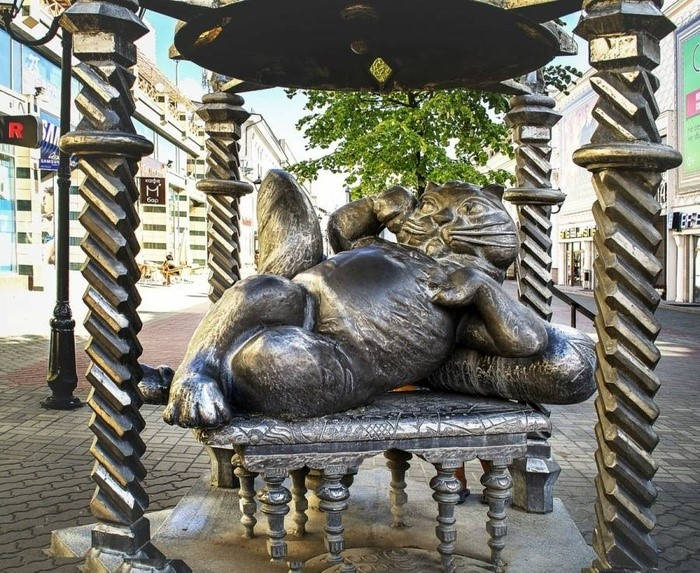
Symbol of the city turned out pretty chubby. The sculpture depicts the image of a cat, lying on a couch, and on the roof of the pavilion is a mouse, frozen in a praying position. The monument was painted the color of aged silver. Colored glass and mirrors decorate the top of the arbor along with the columns.
Next to the monument to the Cat of Kazan, at the foot of his couch is paved with a round carpet, the inscription on which reads:
According to legend, Alabrys is the name of the first Cat of Kazan to appear in the city. Translated from Tatar it means "giant".
- The first proposal to create a sculpture in honor of the Kazan Cat was announced in 2005 at the All-Russian Scientific Conference of Tatarstan;
- the monument was created at the factory of artistic casting in the town of Zhukovsky, Moscow region;
- The cost of the monument was almost one million rubles. The money was donated by patrons of the city of Kazan;
- The first monument to "The Cat of Kazan" is made of stone and installed near Raifa monastery;
- Today "Kazan Cat" is a trademark in Tatarstan.
Since the beginning of the installation of this monument, festivals and exhibitions dedicated to the folkloric figure of the cat have been held annually at the branch of the Kazan State Hermitage Museum.
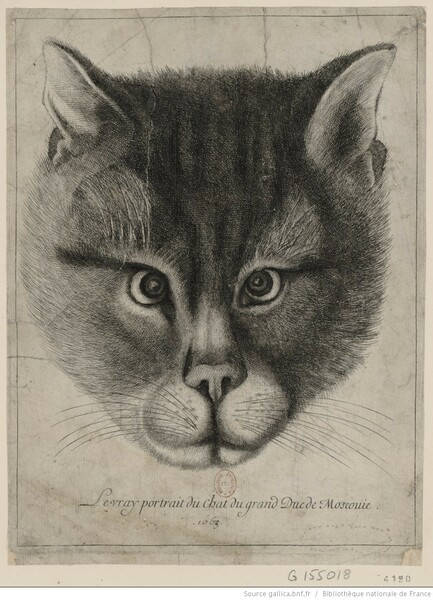
History of the Kazan Cat Monument
The historical figure of the Kazan Cat is intertwined in the folklore of different peoples. Representatives of this very breed became the heroes of legends, legends and bibooks in the period of the 16th-20th centuries.
According to historical legends in the Middle Ages on the territory of Kazan there was a special breed of "fighting" cats, which had it in their blood to catch small rodent pests. According to the description, they were large animals with round and large head, convex forehead, strong neck, strong front and back paws, and a short tail. This breed was also characterized by long and dense white or gray hair, large eyes, and long mustaches.
Some historians attribute the beginning of folklore about the Alabrys cat to the legend of the siege of the Kazan Kremlin in 1552, while others see the emergence of this figure in the legends of the Russo-Kazan war of 1530-1531.
In Russian art the cat appears in such a form of fine art as lubok. A popular 17th-century lubok is called "The Mice Burying the Cat," while another is "The Cat of Kazan," which dates a century later.
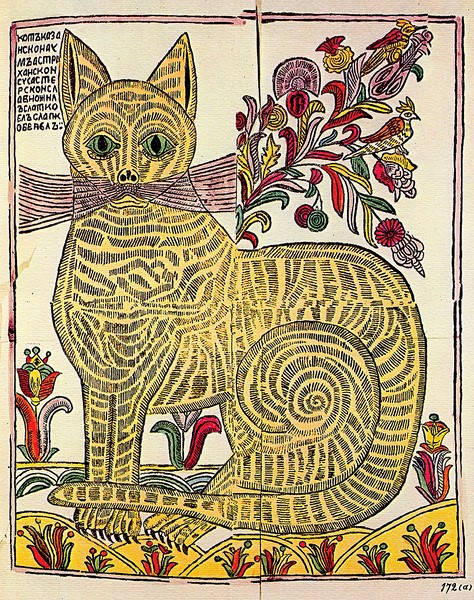
The image of the Kazan Cat is found in many forms of art: in the Russian folk tale "About the Blue Eagle and the Boy", the Russian poet Vasily Andreyevich Zhukovsky used this character in his story "How the Mice Buried the Cat", and a little later, in the 20th century, Mikhail Edisherovich Chiaureli shot a cartoon of the same name.
The legend of the Kazan Cat and Elizabeth Petrovna:
During her arrival in Kazan in 1745, the Empress noticed that there were no rodents in the city. She then issued a decree:
Having found in Kazan the best and biggest thirty cats of local breeds, which are good at catching mice, send them to St. Petersburg to Her Imperial Majesty's court … whoever has them and does not declare them will be fined according to decrees …
… to collect 30 katofeys from Kazan, and send them to St. Petersburg for "state service". That's how the Kazan Taillets appeared in the Winter Palace… whose ancestors still control the population of rodents.
By the way, every year on April 1 the Hermitage staff throws them an "allinclusive" feast… in the style of a buffet March Cat Day!
Actually, the Kazan cat is famous for its mouselike qualities.
3. Next to the monument to the Kazan cat you will find a description of this glorious story in 3 languages.
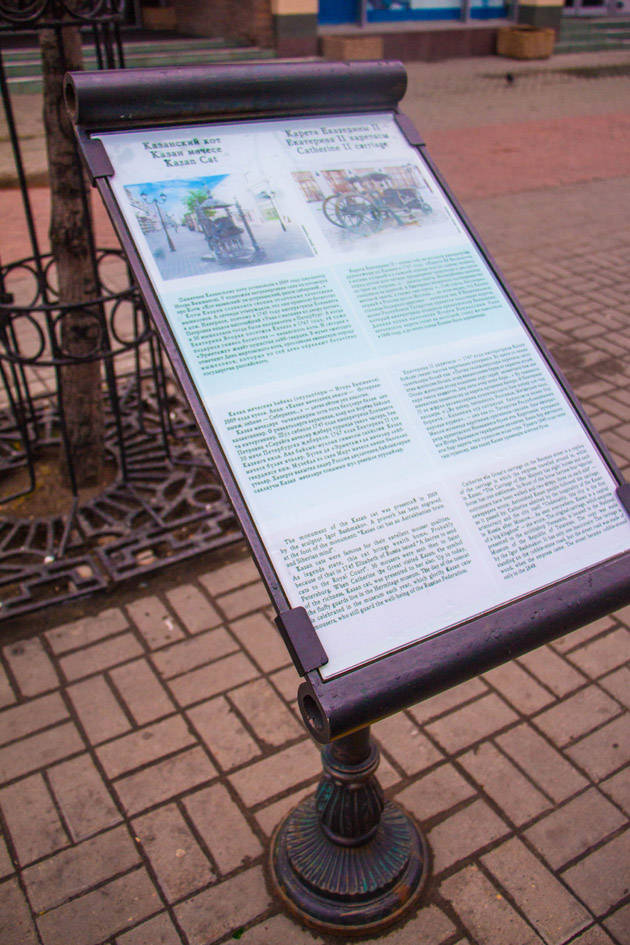
"Alabrys * The cat of Kazan * The mind of Astrakhan, the mind of Siberia. *** Glorious lived, sweetly slept."
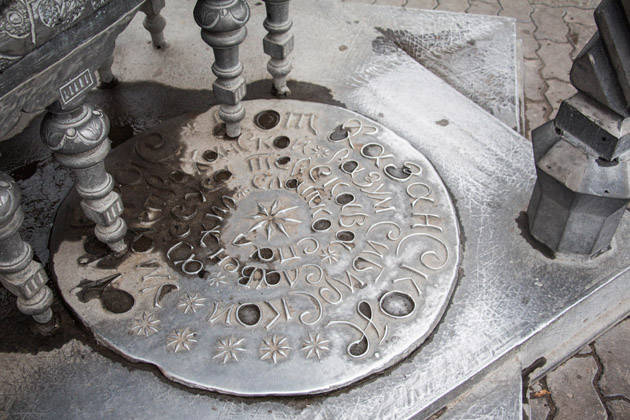
Personally, I don't think the cats of that time were so pot-bellied, otherwise they wouldn't have caught their own tail, not just a mouse…
But still pudgy cat on Bauman takes his cute every 3rd passing by! And for this respect to the author of the sculpture. Igor Bashmakov..
You can buy Kazan cat souvenirs practically in any souvenir shop in Kazan. Cost from 100 rubles.
Kazan cat (Kazan). Picture:
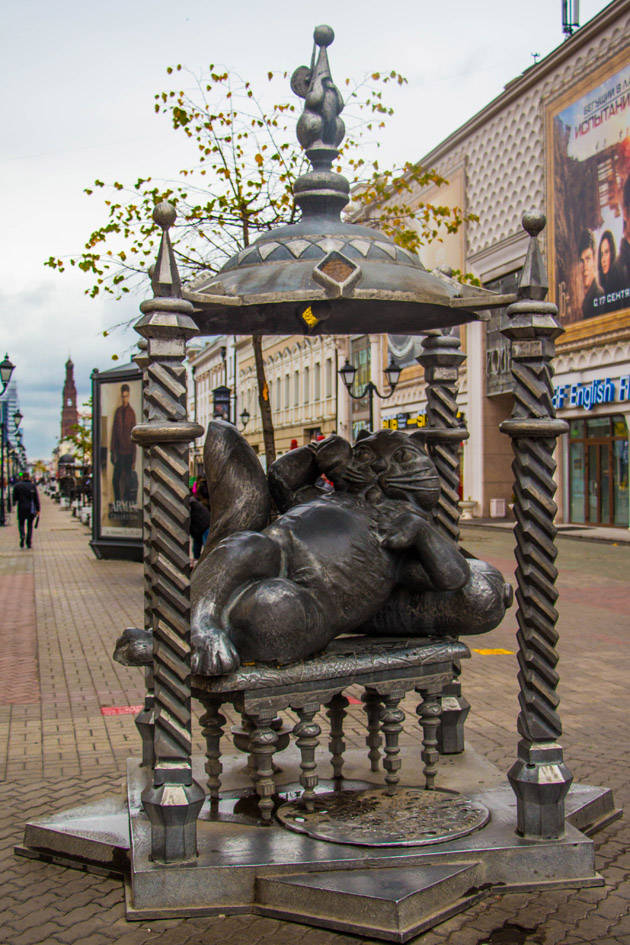
It is obligatory to scratch his belly… and make a wish.…Well he doesn't get it anymore…! 
And if you're hungry, you can go to the "Kazan Cat" Taktir, and there you can have a good meal. It is located 300 meters from the monument.
And for those who value a real… a real live cat more than selfies with the landmark on the Kazan Arbat, go to the Murzyk Cafe… There you will get a purr or a "claw rain" for stroking your belly… it all depends on the chosen belly! 
6. Recently there was "The House of the Giant" and the "Museum of Illusions" on Bauman Street… was anyone already there? Is it worth going? Myself so far only monitored the reviews…
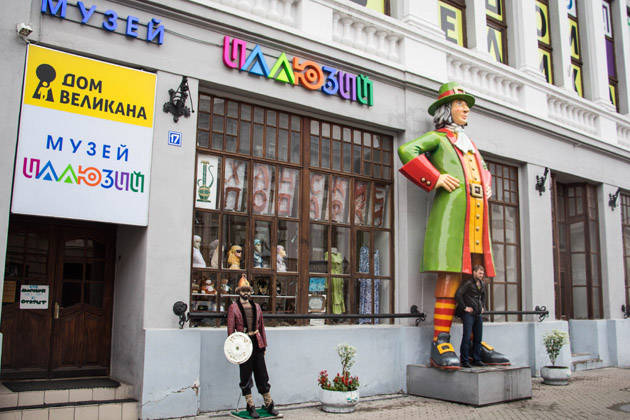
In a future article I will write about my cat…or rather, my NEW cat! It's a cool story…
And I'm going to hold a contest with a money prize there too… so as not to miss the article, sign up for the blog's e-mail updates.
The result of the previous contest… The essence of the contest was this: you had to continue the phrase "Even if the World collapses…" in a funny way. The winner gets 500 rubles.
Due to the small number of participants I did not allocate one best phrase, and highlighted a few cool phrases whose authors will receive 150 rubles each…
Tatiana – (I liked a few) I will select "kefir" – the prize 150 rubles.
Even if the world is falling apart, do not forget to drink kefir for the night.
Ded Mazai – incentive prize 50 rubles for quick decision making! 
That's it, friends… the winners please show their wallet numbers for the prizes! You can find the feedback form on the contact page. Please write from the same mail which you used to leave the comment. 






